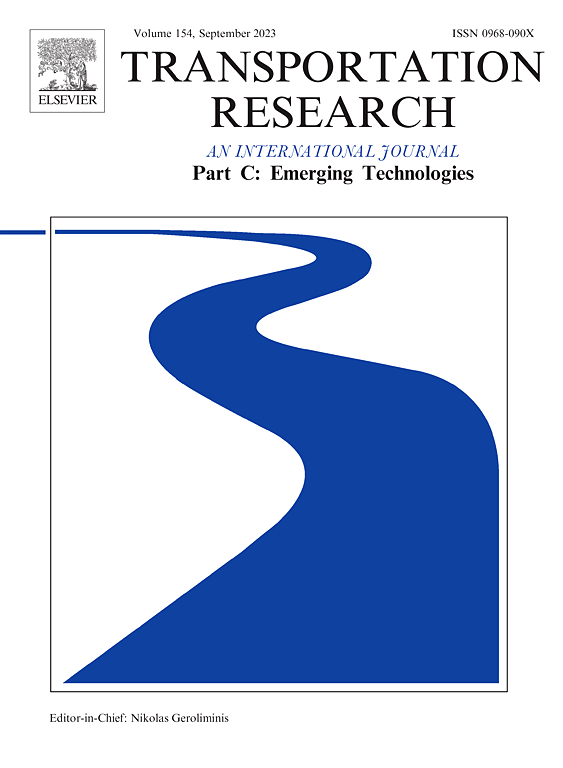在城市交通系统中利用模块化公交车的灵活性
IF 7.6
1区 工程技术
Q1 TRANSPORTATION SCIENCE & TECHNOLOGY
Transportation Research Part C-Emerging Technologies
Pub Date : 2025-04-16
DOI:10.1016/j.trc.2025.105119
引用次数: 0
摘要
尽管交通需求在空间和时间上分布不均,但城市交通系统通常采用固定路线和固定调度方案,使用固定容量车辆。模块化公交车是一种新兴的技术,它可以将容量相对较小的模块动态地停靠在一起,形成容量更大的公交车,从而使公交系统能够适应实际的出行需求。模块可以在预定义的交叉点从一行移动到另一行,如果需要,可以在空时重新定位。我们将这两种操作分别称为共享和再平衡。给定一个包含多条公交线路和出行需求的交通网络,我们提出了一个整数线性规划,以确定线路上模块的最佳分配,从而使出行需求得到最小的模块总数。计算实验表明,与传统公交系统相比,利用模块化公交系统的灵活性,总容量可减少49%,而平均入住率则从41.22%提高到72.85%。本文章由计算机程序翻译,如有差异,请以英文原文为准。
Exploiting the flexibility of modular buses in an urban transit system
Urban transit systems usually operate according to fixed-route and fixed-schedule schemes by employing fixed-capacity vehicles, despite the mobility demand is unevenly spread out in both space and time. Modular buses are an emerging technology in which modules of relatively small capacity can be dynamically docked together to form greater capacity buses and can, therefore, make the transit system capable of adapting the capacity to the actual mobility demand. A module can be shifted from one line to another at pre-defined intersections and can be relocated when empty, if beneficial. We call these two operations sharing and rebalancing, respectively. Given a transit network comprising multiple bus lines and a mobility demand, we present an integer linear program to determine an optimal assignment of modules to lines, so that the mobility demand is met with a minimum total number of modules. Computational experiments show that, by exploiting the flexibility of modular buses, the total capacity deployed can be reduced by 49% with respect to a conventional transit system, whereas the average occupancy ratio increases from 41.22% to 72.85%.
求助全文
通过发布文献求助,成功后即可免费获取论文全文。
去求助
来源期刊
CiteScore
15.80
自引率
12.00%
发文量
332
审稿时长
64 days
期刊介绍:
Transportation Research: Part C (TR_C) is dedicated to showcasing high-quality, scholarly research that delves into the development, applications, and implications of transportation systems and emerging technologies. Our focus lies not solely on individual technologies, but rather on their broader implications for the planning, design, operation, control, maintenance, and rehabilitation of transportation systems, services, and components. In essence, the intellectual core of the journal revolves around the transportation aspect rather than the technology itself. We actively encourage the integration of quantitative methods from diverse fields such as operations research, control systems, complex networks, computer science, and artificial intelligence. Join us in exploring the intersection of transportation systems and emerging technologies to drive innovation and progress in the field.

 求助内容:
求助内容: 应助结果提醒方式:
应助结果提醒方式:


